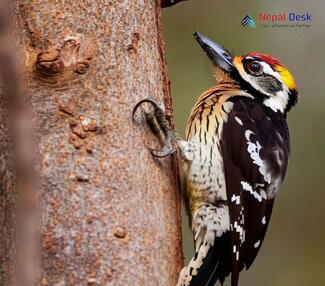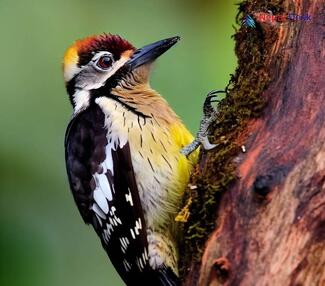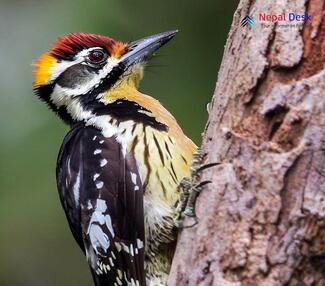Nestled within the stunning Himalayas in the picturesque country of Nepal exists a paradise for birdwatchers and wildlife enthusiasts, thanks to its remarkable variety of bird species. One magnificent example is the Brown-fronted Woodpecker (Dendrocopos auriceps), a medium-sized woodpecker with a remarkable appearance and fascinating habits. Found in lower-to-middle elevation ranges throughout the Himalayan countries like Afghanistan, India, Nepal, Pakistan, and Bhutan, it's a truly captivating sight for those lucky enough to spot this splendid bird in its natural home. Now, let's explore some key aspects of this beautiful creature.
The unique appearance and identifying features of the Brown-fronted Woodpecker make it a standout among birds. Measuring about 20 to 22 centimeters long, its brownish-grey forehead and black cap give it a helmet-like look. The males can be identified by their vibrant red band along the neck's nape. Their wings and upper body are primarily black with white spots and bars, while their underside displays contrasting white and black streaks. The sharp beak and sturdy claws allow them to skillfully navigate tree trunks.
In Nepal's hillsides, deciduous forests and wooded areas play host to this magnificent bird species. Preferring altitudes between 1,500 to 3,000 meters above sea level, the Brown-fronted Woodpecker seeks out trees like oak, rhododendron, and pine for nesting and sourcing food. You can often find these agile creatures hopping up trunks or performing daring acts on branches.
When it comes to their diet, Dendrocopos auriceps feed mainly on insects such as ants, beetles, larvae, as well as spiders. To find food between crevices in bark or woodwork, they use their strong beaks to tunnel through. Additionally, they'll eat berries or fruit depending upon seasonal availability.
Breeding for the Brown-fronted Woodpecker typically takes place between March and June. During this period, the male digs a nest hole in a dead or decaying tree trunk for their family. After inspection by the female, she lays about three to five eggs which both parents incubate for 12 to 14 days. Once a month has passed, the fledglings leave the nest to explore their surroundings and begin their journeys.
As of now, the IUCN Red List of Threatened Species classifies the Brown-fronted Woodpecker as a species of Least Concern due to its stable population and extensive distribution. Nonetheless, habitat destruction remains a major concern for these exquisite birds. Therefore, it's essential not just for birdwatchers but for all nature lovers to support conservation efforts that ensure sustainable ecosystems can continue hosting these amazing creatures.
In summation, Nepal's extraordinary biodiversity presents a one-of-a-kind chance to witness enthralling wildlife like the Brown-fronted Woodpecker up close. Whether you are an avid birdwatcher or merely someone with an appreciation for nature's marvels, be sure to search for this exceptional bird within Nepal's forests – it's bound to be an experience you won't forget.




